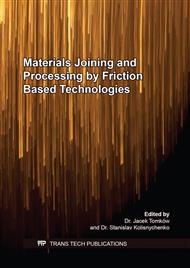p.74
p.84
p.89
p.97
p.102
p.107
p.114
p.119
p.124
Role of Overlap Ratio on the Microstructure of Friction Stir Multiseam Cladded Copper-Stainless Steel Lap Joints
Abstract:
Dissimilar welding of copper to stainless steel using conventional welding processes usually exhibits defects such as solidification cracks, lack of fusion and deterioration in mechanical properties due to the difference in the base metal properties. This is mainly due to minimum solubility of copper in stainless steel. Use of solid state welding such as friction stir welding can be potential solution to this problem. This study is carried out with the aim of cladding copper sheet on a stainless steel by friction stir welding variant known as friction stir cladding. Considering practical applications, to clad copper over stainless steel sheet, multi seam friction stir cladding procedure must be adopted. Though many parameters need to be considered, overlap ratio is one of significant factor which affects the microstructure of clad joints. Hence, five overlap ratios namely 0%, 25 %, 50 %, 75% and 100 % were used to fabricate the dissimilar friction stir copper-stainless steel clad joints. Microstructural analysis was carried out at different regions of clad joints using optical microcopy and correlated with bond strength values
Info:
Periodical:
Pages:
102-106
Citation:
Online since:
March 2020
Authors:
Price:
Сopyright:
© 2020 Trans Tech Publications Ltd. All Rights Reserved
Share:
Citation:



